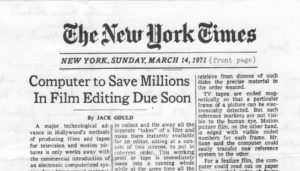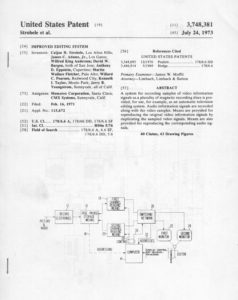Posts Tagged ‘technology’
Technological breakthrough brings excitement
On March 29, 1971 I scrawled a letter to my parents on the back of a copied newspaper clipping. In it I wrote:
We thought you might be interested in this cutting from the New York Times. It was also reproduced in the local paper, as well as the major papers in Chicago, San Francisco and Los Angeles, and the phone hasn’t stopped ringing at CMX [the company where my husband Tony worked] ever since. They have been demonstrating to all the major movie & TV producers & advertising agencies – a fascinating assortment of characters around the place, Tony says. Tony is going to Denver, Colorado for a magnetics conference the week after Easter. I think he is feeling quite amused about confronting the magnetics “Establishment” who were convinced that what he did (using magnetic computer disks to record video pictures) was technically impossible.
 The article, by Jack Gould, the New York Times’s television and radio critic and reporter, goes into more detail. “Computer to Save Millions in Film Editing Due Soon” is its title. Calling it “a major technological advance in Hollywood’s methods of producing films and tapes for television and motion pictures,” he wrote:
The article, by Jack Gould, the New York Times’s television and radio critic and reporter, goes into more detail. “Computer to Save Millions in Film Editing Due Soon” is its title. Calling it “a major technological advance in Hollywood’s methods of producing films and tapes for television and motion pictures,” he wrote:
“In layman’s terms, the heart of the CMX system is its ability to collect and file away all the separate “takes” of a film and make them instantly available for an editor, sitting at a console of two screens, to put in coherent order. This working print or tape is immediately made into a running whole while at the same time all the trims and cuts are preserved for later consideration.
“Operation of the system borders on the eerie. The console operator can order up whatever he wishes to see. He presses no buttons or pulls any switches. Rather, he uses a pencil light that directs the system to offer a choice of “menus,” i.e., whether he wants the system to record, play back or edit.
“If the director wants to see Scene 1 of Act 2, he presses his pencil light, actually a photoelectric cell, against those words on the face of the screen. Instantly there is a still picture denoting that the sequence is ready for study. The light is then pressed against the word “run” and the scene starts.
“With the same pencil light the operator can order the system to stop. He can thereupon order a new starting point and new ending. Thereafter he can review the edited scenes and, if he wishes, compare them with the original.”
CMX Systems was a joint venture between the Columbia Broadcasting System television network and Memorex Corp., the company that had brought us to California in 1967. According to Wikipedia, the company’s name stood for CBS, Memorex, and eXperimental. Tony and his colleagues shared a patent for their work, as well as the satisfaction of having contributed to a breakthrough in technology. The company was sold in 1974, and Tony returned to Memorex, where he continued to work on magnetic recording technologies.
